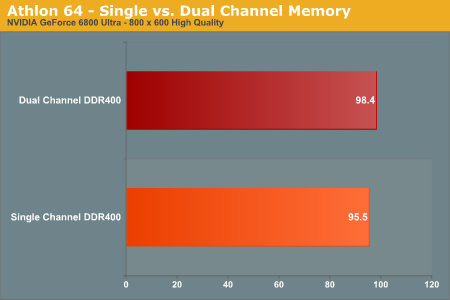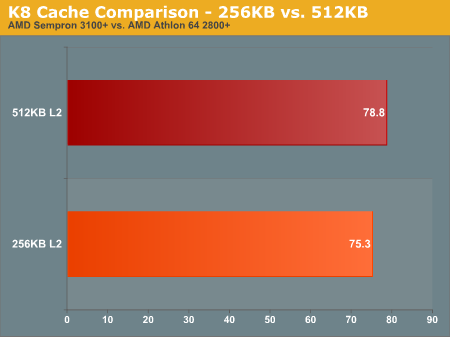Battle 2: AMD vs. AMD
Next up on the fight list for today is AMD, competing against themselves. AMD has gained quite a bit of popularity over the past year and needless to say it is because of their extremely strong showing with the Athlon 64. That being said, with three different flavors of Athlon 64s (Socket-754, Socket-939 and FX) and a lot of users still hanging onto their Athlon XPs, AMD's performance breakdown is an important one to look at.
We know by now that Doom 3 is very cache intensive, which in turns means its very memory intensive - bringing us to our first evaluation: Athlon 64 vs. Athlon 64 FX. The Athlon 64 FX once held two advantages over the Athlon 64, a larger 1MB L2 cache and dual channel memory controller. Now with the introduction of Socket-939, the Athlon 64 also has dual channel capabilities but only on newer chips, not the older Socket-754 offerings. As you can guess, there are two comparisons we'd like to make here: Dual Channel vs Single Channel as well as the impact of cache size on performance.
First we'll tackle dual vs single channel memory interfaces; for this test we used a Socket-939 Athlon 64 FX-51 (2.2GHz/1MB L2) as our Dual Channel platform, and a Socket-754 Athlon 64 3400+ (2.2GHz/1MB L2) as our Single Channel platform. You can see that other than the sockets, the two chips are identical, making this the perfect single vs dual channel memory comparison:

Memory bandwidth doesn't seem to be something that the regular Athlon 64 needs much more of, as the move to dual channel DDR400 only offered a 3% increase in performance. At higher resolutions, the performance advantage would become even smaller. We didn't really expect anything different here, as the dual channel memory interface never really helped the Athlon 64 - definitely not as much as it did the Pentium 4.
Next, let's see how cache size influences Athlon 64 performance under Doom 3. For this comparison we have four chips to compare in two separate sets. We use an Athlon 64 2800+ and a Sempron 3100+, both clocked at 1.8GHz but feature a 512KB and a 256KB L2 cache respectively. We also have an Athlon 64 FX-53 and an Athlon 64 3800+, both clocked at 2.4GHz but feature 1MB and 512KB respective cache sizes. While the four numbers are not directly comparable to one another, the two comparisons do give us an idea of improvements due to cache size varying from 256KB up to 1MB on the Athlon 64:

Looking at the Athlon 64 vs Sempron we see that there's barely a 5% performance difference between the two identically clocked chips, indicating that although a 256KB L2 cache isn't big enough for Doom 3 a 512KB L2 cache doesn't help out that much more. The on-die memory controller helps ensure that despite the small cache size, performance remains very competitive with the competition as we will soon see in our fourth battle.

Our 512KB vs. 1MB L2 cache size comparison reveals something interesting: it's not that a 512KB L2 cache isn't big enough for Doom 3 (which is the case with the Pentium 4), it's that the Athlon 64's on-die memory controller effectively masks the need for a large L2 cache in Doom 3. Going to a 1MB L2 cache results in less than a 4% performance improvement, much less than what we saw with Prescott vs. Northwood.
Bottom line: cache size is far less important for the Athlon 64 than on the Pentium 4 as you would expect thanks to the on-die memory controller.










59 Comments
View All Comments
kabob983 - Thursday, September 9, 2004 - link
kabob983 - Thursday, September 9, 2004 - link
So where does the A64 3200+ fit on this scale anyways...above or below the P4 3.4EE?T0918273645 - Monday, September 6, 2004 - link
this statement from their review is partially wrong."Doom 3 sees system memory as one big cache and drives performance up considerably. It is also the on-die memory controller that makes cache size less of an issue on the Athlon 64, while too small of a cache seems to make or break performance with the Pentium 4."
notice the 3.2 E with its 1mb cache gets 72.8 while the 3.2 C with 512KB cache gets 68.7. the only difference between this chips is the cache, which results in a difference of 4.1 FPS.
look at the FX53, with dual channel, and 1mb cache, it gets 103.4
and the 3800+ with 2.4ghz, 512kb cache, and dual channel gets 99.8
a difference of 3.6. So the larger cache does help. I think maybe anandtech might have mixed up the fact that they were comparing with amd the difference between dual channel, and cache. while with intel they were comparing only the difference between caches.
i think looking at the AMD charts you can see how close amd's view of the tradeoff for dual channel with the loss of half the cache actually is, at least as far as doom3 is concerned.
The 3400+ (no dual channel, 1mb cache, and 2.2ghz) performs at 80.4 FPS
The 3500+ (dual channel, 512KB cache, 2.2ghz) turns in 79.5FPS. So the dual channel/ cache tradeoff is so close you'd never be able to tell the difference.
So basically they mixed up the fact that the smaller cach size of the 3500+ compared to the 3400+ is masked by the dual channel ram which nearly completely makes up for the loss in cache.
I'm surpised they overlooked that fact.
Or maybe they thought that a difference of 4.1 is more of an issue than a difference of 3.6, but really that difference is nearly the same.
manson909 - Monday, August 9, 2004 - link
i can't believe no one has thought of this: since Doom 3 is capped at 60FPS, why not compare the MINIMUM framerates the CPU's encounter when playing? a system that has an average of 60FPS but is locked in at this speed (no dips) is far superior than a system that has an average of 70FPS but with lows in the 20's & high's in the 100's imo... anyone?HermosaBeach - Friday, August 6, 2004 - link
Short version:I would like to see the final graph comparing CPUs using 1600x1200, Highest Quality, 4xAA (Anti-Aliasing) and 16xAF (Anisotropic Filtering)
With this graph we may actually see a flattening of the frames per second where an increase in the CPU has no real impact on frames per second. This is where the GPU (GeForce 6800 Ultra) hits the wall and becomes the limiting factor.
Dave
HermosaBeach - Friday, August 6, 2004 - link
Dear 53, I disagree. Here's another way to look at the problem or question. Let's say I own an ATI X800 XT PE. I would like to know what computer (CPU/MB) to get. I want to play games at 1600x1200 with 6xAA and 16xAF. Starting from the slowest computer like the AMD XP 2000+. As you improve the CPU and climb the performance ladder we expect the frames per second to increase. But, there may come a time where an increase in CPU does not appreciably increase the frame rate. At this CPU level getting a faster CPU is not really going to help you. I was hoping to find this magical CPU point. Early 2003, with my ATI 9800 Pro, the sweet spot was the AMD XP 1800+. A faster CPU imporved frames per second, but not by much and was not worth the significantly increase in cost. For example, with FarCry and Doom3 the AMD 64 3000+ might be the sweet spot where getting the AMD 6400 3700+ really does not significantly increase your frame rate. If this is true, I would get the AMD 64 3000+. If the frame per second continue to significant improve as you increase the CPU then I would get the top end CPU. Sadly, at 1280x1024 without 4xAA and 16xAF you really can't tell.Dave
skiboysteve - Friday, August 6, 2004 - link
Dave, your retarded. Try reading the review, esp the first page.HermosaBeach - Thursday, August 5, 2004 - link
This article should have used 1280x1024 and 1600x1200. The 800x600 resolution was a waste of time and reading. Who's going to purchase any AMD 64 or any ATI X800 series or NVidia 6800 series card and play at such pathetic resolutions. I found the article a waste of time and it certainly did NOT answer the question - what CPU to get. I own a ATI 9800 Pro and it certainly did not help with what CPU to get when I purchase my next graphics card - sigh.Dave
xxxfubar187xxx - Thursday, August 5, 2004 - link
Thanks for the benchmarks guys! You do great work over there. Why wasn't the Athlon64 3700+ included in these benchmarks? Being the top of the line Socket 754 processor I figured it would be included in the tests.gimpyd00 - Thursday, August 5, 2004 - link